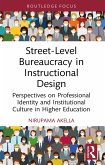Issues in Technology, Learning, and Instructional Design (eBook, PDF)
Classic and Contemporary Dialogues
Redaktion: Carr-Chellman, Alison A.; Rowland, Gordon


Alle Infos zum eBook verschenken

Issues in Technology, Learning, and Instructional Design (eBook, PDF)
Classic and Contemporary Dialogues
Redaktion: Carr-Chellman, Alison A.; Rowland, Gordon
- Format: PDF
- Merkliste
- Auf die Merkliste
- Bewerten Bewerten
- Teilen
- Produkt teilen
- Produkterinnerung
- Produkterinnerung

Hier können Sie sich einloggen

Bitte loggen Sie sich zunächst in Ihr Kundenkonto ein oder registrieren Sie sich bei bücher.de, um das eBook-Abo tolino select nutzen zu können.
In Issues in Technology, Learning, and Instructional Design, some of the best-known scholars in those fields produce powerful, original dialogues that clarify current issues, provide context and theoretical grounding, and illuminate a framework for future thought. Position statements are introduced and then responded to, covering a remarkably broad series of topics across educational technology, learning, and instructional design, from tool use to design education to how people learn. Reminiscent of the well-known Clark/Kozma debates of the 1990s, this book is a must-have for professionals in…mehr
- Geräte: PC
- mit Kopierschutz
- eBook Hilfe
- Größe: 1.57MB
![An Architectural Approach to Instructional Design (eBook, PDF) An Architectural Approach to Instructional Design (eBook, PDF)]() Andrew S. GibbonsAn Architectural Approach to Instructional Design (eBook, PDF)60,95 €
Andrew S. GibbonsAn Architectural Approach to Instructional Design (eBook, PDF)60,95 €![Historical Instructional Design Cases (eBook, PDF) Historical Instructional Design Cases (eBook, PDF)]() Historical Instructional Design Cases (eBook, PDF)41,95 €
Historical Instructional Design Cases (eBook, PDF)41,95 €![Learning, Problem Solving, and Mindtools (eBook, PDF) Learning, Problem Solving, and Mindtools (eBook, PDF)]() Learning, Problem Solving, and Mindtools (eBook, PDF)53,95 €
Learning, Problem Solving, and Mindtools (eBook, PDF)53,95 €![Culture, Learning, and Technology (eBook, PDF) Culture, Learning, and Technology (eBook, PDF)]() Culture, Learning, and Technology (eBook, PDF)43,95 €
Culture, Learning, and Technology (eBook, PDF)43,95 €![Trends and Issues in Instructional Design and Technology (eBook, PDF) Trends and Issues in Instructional Design and Technology (eBook, PDF)]() Trends and Issues in Instructional Design and Technology (eBook, PDF)57,95 €
Trends and Issues in Instructional Design and Technology (eBook, PDF)57,95 €![Street-Level Bureaucracy in Instructional Design (eBook, PDF) Street-Level Bureaucracy in Instructional Design (eBook, PDF)]() Nirupama AkellaStreet-Level Bureaucracy in Instructional Design (eBook, PDF)19,95 €
Nirupama AkellaStreet-Level Bureaucracy in Instructional Design (eBook, PDF)19,95 €![Universal Access Through Inclusive Instructional Design (eBook, PDF) Universal Access Through Inclusive Instructional Design (eBook, PDF)]() Universal Access Through Inclusive Instructional Design (eBook, PDF)41,95 €
Universal Access Through Inclusive Instructional Design (eBook, PDF)41,95 €-
-
-
Dieser Download kann aus rechtlichen Gründen nur mit Rechnungsadresse in A, B, BG, CY, CZ, D, DK, EW, E, FIN, F, GR, HR, H, IRL, I, LT, L, LR, M, NL, PL, P, R, S, SLO, SK ausgeliefert werden.
- Produktdetails
- Verlag: Taylor & Francis eBooks
- Seitenzahl: 231
- Erscheinungstermin: 1. Dezember 2016
- Englisch
- ISBN-13: 9781317484301
- Artikelnr.: 47382109
- Verlag: Taylor & Francis eBooks
- Seitenzahl: 231
- Erscheinungstermin: 1. Dezember 2016
- Englisch
- ISBN-13: 9781317484301
- Artikelnr.: 47382109
- Herstellerkennzeichnung Die Herstellerinformationen sind derzeit nicht verfügbar.
Part 1: The Nature of Design
1. The Relationship of Instructional Design to the Broad Field of Design by
Patrick Parrish
* Response by Harold Nelson
* Rejoinder by Patrick Parrish
* Toward Understanding the Nature of Design by Brenda Bannan
* Response by Andrew S. Gibbons
* Rejoinder by Brenda Bannan
* Guerrilla Design: How Can We Accommodate Against-the-Grain Thinking
in Our Practice? by Brent Wilson
* Response by Barbara L. Martin
* Rejoinder by Brent G. Wilson
* Design Beyond Content: Extending the Value of Educational Technology;
an Examination of the Role or the Anti-Role of Content in Educational
Technology by Brad Hokanson
* Response by Peter Samuelson Wardrip
* Rejoinder by Brad Hokanson
* The Systems Approach to Instructional Development by Michael Molenda
* Response by Thomas Argondizza
* Rejoinder by Michael Molenda
* Instructional Design Models and the Expertise Required to Practice
True Instructional Design by Robert Maribe Branch
* Response by Lloyd P. Rieber
* Rejoinder by Robert Maribe Branch
Part 2: Preparing Designers
Introduction to Part 2
* Developing Design Expertise by Kathleen Fortney
* Response by Elizabeth Boling
* Rejoinder by Kathleen Fortney
* Design Education as a Site for Educating Disciplines by Kennon M.
Smith
* Response by Atsusi Hirumi
* Rejoinder by Kennon M. Smith
* Necessary Ingredients for the Education of Designers by Irene
Visscher-Voerman
* Response by Monica Tracey
* Rejoinder by Irene Visscher-Voerman
* Teaching the Complex Performance of Instructional Design: Why We
Cannot Use the (Existing) Tools of Instructional Design by Elizabeth
Boling
* Response by M. David Merrill
* Rejoinder by Elizabeth Boling
* My Hope for the Future of Instructional Technology by M. David
Merrill
* Response by Tonia A. Dousay
* Rejoinder by M. David Merrill
* Preparing Instructional Designers by Monica W. Tracey
* Response by Brad Hokanson
* Rejoinder by Monica W. Tracey
Part 3: Context
Introduction to Part 3
* Education is Completely Broken by Roger C. Schank
* Response by Kyle Peck
* Rejoinder by Roger C. Schank
* Paradigm Change: Its Time Is Now by Charles M. Reigeluth
* Response by Roger C. Schank
* Rejoinder by Charles M. Reigeluth
* The Unbalancing of Corporate Systems: The Neuroscience of Intellect
vs. Wisdom by Anthony Marker
* Response by Rob Foshay
* Rejoinder by Anthony Marker
* Women in Educational Technology by Audrey Watters
* Response by Rose Marra
Part 4: Technology
Introduction to Part 4
* The Learner-Centered Paradigm of Instruction by Charles M. Reigeluth
* Response by Stephen W. Harmon
* Rejoinder by Charles M. Reigeluth
* Learning From and With Media and Technology by Thomas C. Reeves
* Response by Wilhelmina C. Savenye
* Rejoinder by Thomas C. Reeves
* Building Educational Technologies to Scale in Schools by Rob Foshay
* Response by MJ Bishop
* Rejoinder by Rob Foshay
* For the Foreseeable Future, Instructional Technology Devices and
Products-No Matter How Well Designed-Will Not Eliminate the Need for
Human Teachers by Ward Mitchell Cates and Thomas C. Hammond
* Response by Sugata Mitra
* Rejoinder by Ward Mitchell Cates and Thomas C. Hammond
* What's Next for E-Learning? By John Savery
* Response by Clark Quinn
* Rejoinder by John Savery
* Any Time, Any Place, Any Pace ... by Kathryn Kennedy and Joseph R.
Friedhoff
* Response by Victoria Raish
* Rejoinder by Kathryn Kennedy and Joseph R. Friedhoff
Part 5: Learning Science
Introduction to Part 5
* Points of Contact: Educational Technology and the Learning Sciences
by Andrew S. Gibbons
* Response by Jason Yip
* Rejoinder by Andy Gibbons
* Bring Design to Design-Based Research by Gordon Rowland
* Response by Heather Toomey Zimmerman
* Rejoinder by Gordon Rowland
* Participatory Design by Jason Yip
* Response by Thomas C. Reeves
* Rejoinder by Jason Yip
Conclusion
Part 1: The Nature of Design
1. The Relationship of Instructional Design to the Broad Field of Design by
Patrick Parrish
* Response by Harold Nelson
* Rejoinder by Patrick Parrish
* Toward Understanding the Nature of Design by Brenda Bannan
* Response by Andrew S. Gibbons
* Rejoinder by Brenda Bannan
* Guerrilla Design: How Can We Accommodate Against-the-Grain Thinking
in Our Practice? by Brent Wilson
* Response by Barbara L. Martin
* Rejoinder by Brent G. Wilson
* Design Beyond Content: Extending the Value of Educational Technology;
an Examination of the Role or the Anti-Role of Content in Educational
Technology by Brad Hokanson
* Response by Peter Samuelson Wardrip
* Rejoinder by Brad Hokanson
* The Systems Approach to Instructional Development by Michael Molenda
* Response by Thomas Argondizza
* Rejoinder by Michael Molenda
* Instructional Design Models and the Expertise Required to Practice
True Instructional Design by Robert Maribe Branch
* Response by Lloyd P. Rieber
* Rejoinder by Robert Maribe Branch
Part 2: Preparing Designers
Introduction to Part 2
* Developing Design Expertise by Kathleen Fortney
* Response by Elizabeth Boling
* Rejoinder by Kathleen Fortney
* Design Education as a Site for Educating Disciplines by Kennon M.
Smith
* Response by Atsusi Hirumi
* Rejoinder by Kennon M. Smith
* Necessary Ingredients for the Education of Designers by Irene
Visscher-Voerman
* Response by Monica Tracey
* Rejoinder by Irene Visscher-Voerman
* Teaching the Complex Performance of Instructional Design: Why We
Cannot Use the (Existing) Tools of Instructional Design by Elizabeth
Boling
* Response by M. David Merrill
* Rejoinder by Elizabeth Boling
* My Hope for the Future of Instructional Technology by M. David
Merrill
* Response by Tonia A. Dousay
* Rejoinder by M. David Merrill
* Preparing Instructional Designers by Monica W. Tracey
* Response by Brad Hokanson
* Rejoinder by Monica W. Tracey
Part 3: Context
Introduction to Part 3
* Education is Completely Broken by Roger C. Schank
* Response by Kyle Peck
* Rejoinder by Roger C. Schank
* Paradigm Change: Its Time Is Now by Charles M. Reigeluth
* Response by Roger C. Schank
* Rejoinder by Charles M. Reigeluth
* The Unbalancing of Corporate Systems: The Neuroscience of Intellect
vs. Wisdom by Anthony Marker
* Response by Rob Foshay
* Rejoinder by Anthony Marker
* Women in Educational Technology by Audrey Watters
* Response by Rose Marra
Part 4: Technology
Introduction to Part 4
* The Learner-Centered Paradigm of Instruction by Charles M. Reigeluth
* Response by Stephen W. Harmon
* Rejoinder by Charles M. Reigeluth
* Learning From and With Media and Technology by Thomas C. Reeves
* Response by Wilhelmina C. Savenye
* Rejoinder by Thomas C. Reeves
* Building Educational Technologies to Scale in Schools by Rob Foshay
* Response by MJ Bishop
* Rejoinder by Rob Foshay
* For the Foreseeable Future, Instructional Technology Devices and
Products-No Matter How Well Designed-Will Not Eliminate the Need for
Human Teachers by Ward Mitchell Cates and Thomas C. Hammond
* Response by Sugata Mitra
* Rejoinder by Ward Mitchell Cates and Thomas C. Hammond
* What's Next for E-Learning? By John Savery
* Response by Clark Quinn
* Rejoinder by John Savery
* Any Time, Any Place, Any Pace ... by Kathryn Kennedy and Joseph R.
Friedhoff
* Response by Victoria Raish
* Rejoinder by Kathryn Kennedy and Joseph R. Friedhoff
Part 5: Learning Science
Introduction to Part 5
* Points of Contact: Educational Technology and the Learning Sciences
by Andrew S. Gibbons
* Response by Jason Yip
* Rejoinder by Andy Gibbons
* Bring Design to Design-Based Research by Gordon Rowland
* Response by Heather Toomey Zimmerman
* Rejoinder by Gordon Rowland
* Participatory Design by Jason Yip
* Response by Thomas C. Reeves
* Rejoinder by Jason Yip
Conclusion







